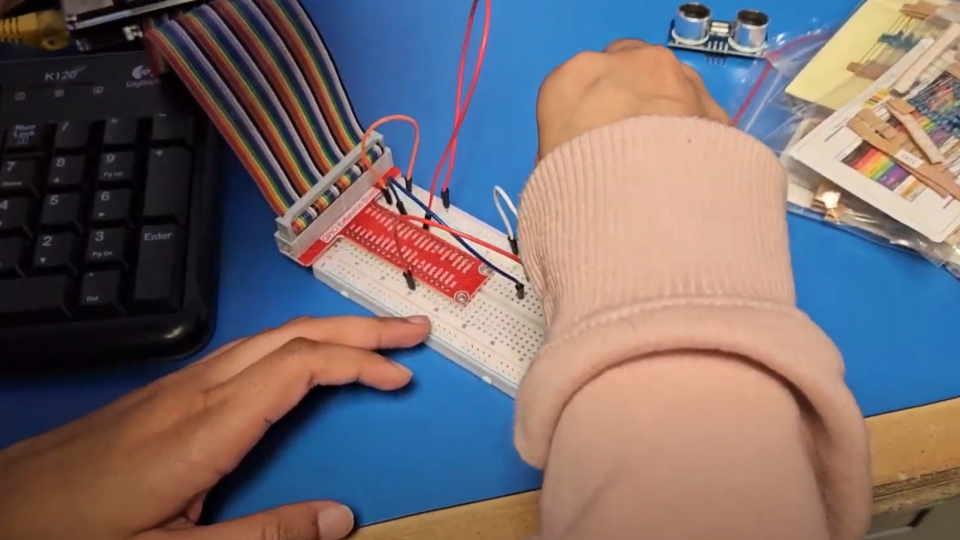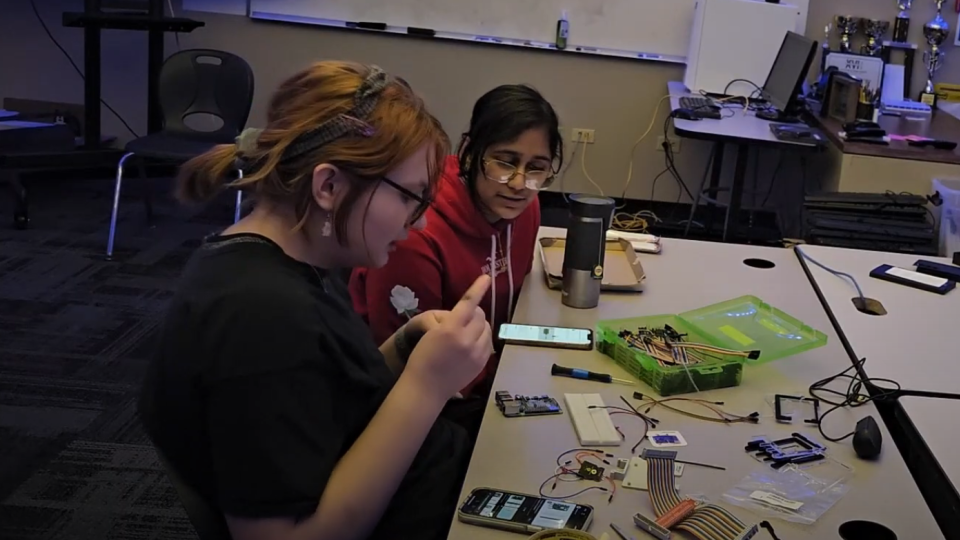Many high schools are curbing the use of AI. These schools are leaning in
At Princeton High School, students are trying to combat the rapid decline of indigenous languages with some unlikely help: a furry, wide-eyed stuffed animal named Che’w.
But Che’w isn’t a standard plush toy. He’s a wildly intelligent generative AI robot that speaks Mam, a Mayan language spoken in the western highlands of Guatemala and Mexico and by a small population of the school’s students. The language is currently at risk of extinction, according to UNESCO; the students hope Che’w can help change that.
At a time when some high schools are restricting the use of AI in the classroom, others, like Princeton High School, are leaning into it.
In the short 18 months since the launch of viral chatbot ChatGPT, generative AI has emerged as a revolutionary technology in the field of artificial intelligence. Its capabilities have impressed both users and experts with its ability to perform a range of tasks, from generating creative content, essays and games to conducting mathematical equations, summarizing complicated concepts and more. All that is already reshaping various parts of our lives, including education.
But the technology has leaped ahead far faster, in many cases, than schools’ understanding of how to use it. And with new products out this week from Google’s XYZ initiative and OpenAI’s new GPT-4o, many teachers and districts realize they cannot avoid the subject.
Dr. Joy Barnes-Johnson, the science administrator for PHS, said the school is “trying to embrace AI” as much as possible. “It’s a tool, just like a pencil is technology that helps communication.”
She said the school will host an AI summit this summer with its teachers and administrators to have a conversation about how generative AI should or shouldn’t be used in the classroom.
“In the beginning of the school year, we talked about how AI is the world we’re in now and we have a responsibility to prepare kids for the world they will inherit,” she said. “The idea is that it will help people connect and learn, so we [as teachers] have to not be afraid of it.”

Proceeding with caution
When ChatGPT launched in November 2022, teachers worried that the tool, which can generate convincing responses and essays in response to user prompts, could make it easier for students to cheat on assignments. Some also worried ChatGPT and similar tools could be used to spread inaccurate information.
Not long after its launch, New York City public schools became one of the first school districts to ban students and teachers from using ChatGPT on the district’s networks and devices.
Other schools reacted similarly in the weeks and months that followed, including the Los Angeles Unified School District and Seattle Public Schools, which blocked access to ChatGPT on their networks.
Some of these districts have evolved their policies over time. The LAUSD, for example, has since launched a chatbot named “Ed” to act as a student advisor, with the ability to inform parents about information ranging from children’s test results to their school attendance.
Many schools also continue to grapple with how to best approach the technology inside the classroom.
“There is acceptance by educators, but we’re still seeing a lot of caution,” said Noel Candelaria, the secretary-treasurer of the National Education Association who is leading the charge around the union’s AI policy. “The challenge is there isn’t a lot of guidance on the district level, so the concern educators have is that it’s being something done to them, instead of with them.”
He added: “There are also major concerns around data confidentiality and where data is being pulled from.”
Candelaria told CNN that educators feel strongly that they want their voice to influence how it can be applied to schools. The NEA is developing a task force with educators across the country to address many of these issues.

Beyond generative AI
Some high schools around the country are trying to teach students how to use other forms of artificial intelligence for a greater good. At one prestigious public school in New York City, Stuyvesant High School, students created an app for the blind that uses artificial intelligence and tactile feedback to help people detect threats and navigate obstacles.
Similarly, at STEM School Highlands Ranch in Colorado, a team of students developed an AI-powered wildlife detection system called Project Deer to help cut down on car crashes. Although researchers have tried to combat such accidents before, studies have shown wildlife don’t consistently react to any one stimulus. So the students instead derived an AI-based predictive solution to alert the driver to an imminent threat on the road.
Using four $5 infrared detection sensors placed on vehicles, the students developed a system for AI to scan the surroundings and emit a high-pitched sound when an animal’s body heat is detected, a signal that may help to scare the animal away.
The school, which was the Colorado State Winner in Samsung’s annual Solve for Tomorrow competition, said it is partnering with the University of Colorado in Boulder this summer to help boost its success rate. The Solve for Tomorrow contest featured more than 1,000 schools submitting STEM-based solutions to real-world problems. Samsung told CNN there was a “definite uptick in” submitted AI-powered innovations this year compared to previous years.
Computer science teacher Tylor Chacon told CNN the group’s big vision is to one day have the technology regulated or adopted by the state for greater use.
School administration has told teachers to help create rubrics or lesson plans, Chacon told CNN. “We’ve been encouraged to embrace it and look into ways we can use it to maximize our own job effectiveness and ease the burden on us,” he said.
It’s an increasingly common trend among teachers to use AI tools to create assignments, quizzes, polls, videos and interactives for classroom use. Some are even turning to AI tools and platforms — such as ChatGPT, Writable, Grammarly and EssayGrader — to assist with grading papers or writing feedback, a practice that is also raising ethical considerations.
Saving a language, learning the future
Still, as schools continue to weigh the benefits or disadvantages to teaching and using artificial intelligence, some teachers and administrators feel strongly that it’s the future.
At Princeton High, a group of about 14 students met during school hours for months to build out Che’w’s conversational capabilities, drawn from artificial intelligence neural networks that are trained to recognize patterns, solve problems and understand words, sentences and phrases from spoken and written language.
Che’w, which translates to “star” in Mam, was trained to understand the language by the students so it can serve as a personal tutor. The robot is also trained to speak Spanish and English.
“It doesn’t lose patience or get sick of talking to them,” said Mark Eastburn, Princeton High School’s science, research and engineering teacher. “It’s taking [AI] off the screen and putting it onto a physical structure that looks like a friend that can help you do whatever you need to do.”
In April, the students were one of the top three National Winners at the Samsung Solve For Tomorrow’s competition.
AI is now a part of students’ lives, Eastburn said.
“And it will be there when they’re in college and also in their careers,” he added, “so they might as well learn and use it in appropriate ways in high school, if not even earlier.”
For more CNN news and newsletters create an account at CNN.com

 Yahoo Finance
Yahoo Finance 